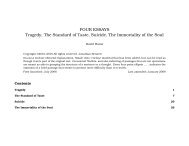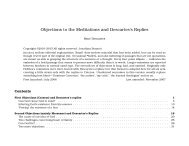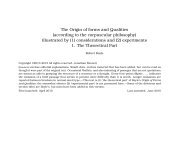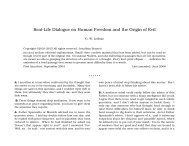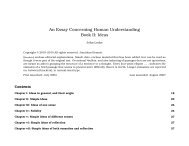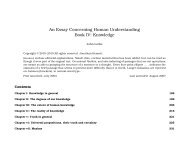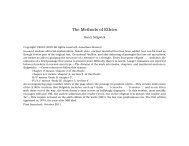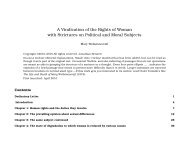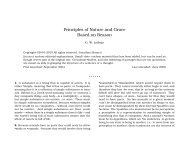The Form and Principles of the Sensible and Intelligible World
The Form and Principles of the Sensible and Intelligible World
The Form and Principles of the Sensible and Intelligible World
Create successful ePaper yourself
Turn your PDF publications into a flip-book with our unique Google optimized e-Paper software.
<strong>The</strong> <strong>Sensible</strong> <strong>and</strong> <strong>Intelligible</strong> <strong>World</strong> Immanuel Kant IV: <strong>The</strong> form <strong>of</strong> <strong>the</strong> intelligible world<br />
<strong>the</strong> interaction <strong>of</strong> substances (i.e. <strong>the</strong> two-way dependence<br />
<strong>of</strong> <strong>the</strong>ir states) doesn’t follow from <strong>the</strong>ir mere<br />
existence,<br />
but also this one:<br />
interaction can’t be attributed at all to substances that<br />
are necessary things.<br />
[Kant seems here to ignore <strong>the</strong> distinction that he stressed back on<br />
page 3, where he clearly implied that substances might be ‘independent<br />
<strong>of</strong> one ano<strong>the</strong>r so far as <strong>the</strong>ir •existence is concerned’ yet ‘depend on one<br />
ano<strong>the</strong>r for <strong>the</strong> •states <strong>the</strong>y are in’. It’s bewildering. If you want to check<br />
on this yourself, <strong>the</strong> Latin <strong>and</strong> two previous translations can be found on<br />
page 26.]<br />
19. Thus a whole <strong>of</strong> substances is a whole <strong>of</strong> contingents,<br />
·i.e. things that exist contingently, not necessarily·. It’s an<br />
essential fact about any world that it is composed <strong>of</strong> mere<br />
contingents. <strong>The</strong> only way a necessary substance could<br />
be ·causally· linked with a world is by being its cause. It<br />
can’t be linked as a part, for that would involve its being<br />
involved in two-way inter-dependence with <strong>the</strong> o<strong>the</strong>r parts,<br />
<strong>and</strong> that’s ruled out for a necessary entity. <strong>The</strong>refore <strong>the</strong><br />
cause <strong>of</strong> <strong>the</strong> world—·if it has a cause·—is right outside <strong>the</strong><br />
world; so it isn’t <strong>the</strong> soul <strong>of</strong> <strong>the</strong> world, ·as various religions<br />
<strong>and</strong> philosophies have thought it to be·. And its presence<br />
in <strong>the</strong> world is not local but virtual. [In a Note at <strong>the</strong> end <strong>of</strong><br />
this Section Kant will flesh out that last sentence: <strong>the</strong> cause <strong>of</strong> <strong>the</strong> world<br />
isn’t in <strong>the</strong> world by being somewhere in it or everywhere in it, but by<br />
being inwardly present to things, thus making it possible for <strong>the</strong>m to be<br />
spatially related to one ano<strong>the</strong>r.]<br />
20. Substances that are in <strong>the</strong> world derive from something<br />
o<strong>the</strong>r than <strong>the</strong>mselves; but not from several such<br />
somethings—<strong>the</strong>y all derive from one entity. If <strong>the</strong>y were<br />
caused by several necessary beings, <strong>the</strong>y couldn’t interact<br />
17<br />
with one ano<strong>the</strong>r because <strong>the</strong>ir different causes couldn’t.<br />
Thus, what makes <strong>the</strong> substances in <strong>the</strong> universe hang<br />
toge<strong>the</strong>r as one world is a consequence <strong>of</strong> <strong>the</strong>ir all coming<br />
from one cause. . . . And <strong>the</strong>re can’t be an architect <strong>of</strong> <strong>the</strong><br />
world who isn’t also its creator.<br />
21. If <strong>the</strong>re were several first <strong>and</strong> necessary causes, <strong>and</strong><br />
things caused by <strong>the</strong>m, <strong>the</strong> upshot would be worlds, not a<br />
world, because <strong>the</strong> things wouldn’t all be inter-connected in<br />
such a way as to constitute a single whole. And conversely if<br />
<strong>the</strong>re were several non-overlapping worlds, <strong>the</strong>y would have<br />
to come from several first <strong>and</strong> necessary causes; <strong>the</strong> lack <strong>of</strong><br />
interaction between any two <strong>of</strong> <strong>the</strong> worlds would result from<br />
<strong>the</strong> lack <strong>of</strong> interaction between <strong>the</strong> respective world-causes.<br />
So it’s not <strong>the</strong> case (as Wolff thought it is . . . .) that <strong>the</strong><br />
very concept <strong>of</strong> world makes it impossible that <strong>the</strong>re should<br />
two or more non-overlapping actual worlds. All we can say<br />
about <strong>the</strong> possibility <strong>of</strong> several worlds is that if <strong>the</strong>re’s only<br />
one necessary cause <strong>of</strong> everything <strong>the</strong>re can’t be more than<br />
one world. If <strong>the</strong>re is more than one necessary cause, it will<br />
be possible—in <strong>the</strong> strictest metaphysical sense—for <strong>the</strong>re<br />
to be that many non-overlapping worlds.<br />
22. From <strong>the</strong> existence <strong>of</strong> a world we can validly infer that<br />
<strong>the</strong>re’s a single cause <strong>of</strong> all its parts; if it’s also valid to infer,<br />
in <strong>the</strong> opposite direction, from <strong>the</strong>ir having a single common<br />
cause that <strong>the</strong>y are interconnected, this being <strong>the</strong> form <strong>of</strong><br />
<strong>the</strong> world (though I admit this second inference doesn’t seem<br />
to me as clear <strong>the</strong> first), <strong>the</strong>n <strong>the</strong> fundamental interlinking <strong>of</strong><br />
substances would be not contingent but necessary because<br />
<strong>the</strong>y would all be sustained by a common principle. This<br />
interlinking would create a •harmony •coming from <strong>the</strong> sheer<br />
fact <strong>of</strong> <strong>the</strong>ir existence, •based on <strong>the</strong>ir common cause, <strong>and</strong><br />
•unrolling according to common rules. I call this kind <strong>of</strong>




